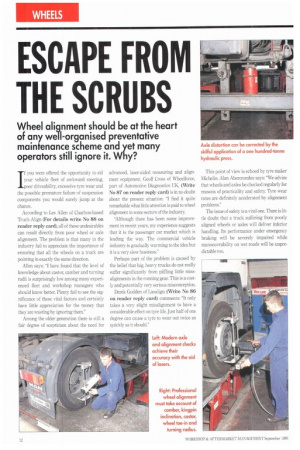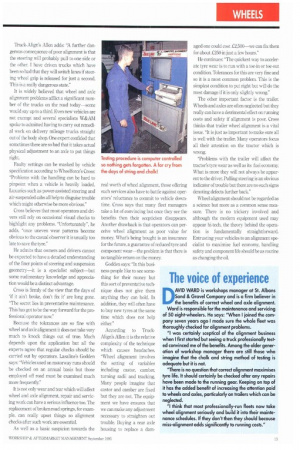ESCAPE FROM THE SCRUBS
Page 104

Page 105

If you've noticed an error in this article please click here to report it so we can fix it.
If you were offered the opportunity to rid your vehicle fleet of awkward steering, poor driveability, excessive tyre wear and the possible premature failure of suspension components you would surely jump at the chance.
According to Les Allen of Charlton-based Truck-Align (For details write No 88 on reader reply card), all of these undesirables can result directly from poor wheel or axle alignment. The problem is that many in the industry fail to appreciate the importance of ensuring that all the wheels on a truck are pointing in exactly the same direction.
Allen says: "I have found that the level of knowledge about castor, camber and turning radii is surprisingly low among many experienced fleet and workshop managers who should know better. Plenty fail to see the significance of these vital factors and certainly have little appreciation for the money that they are wasting by ignoring them."
Among the older generation there is still a fair degree of scepticism about the need for advanced, laser-aided measuring and alignment equipment. Geoff Cross of Wheelforce, part of Automotive Diagnostics UK, (Write No 87 on reader reply card) is in no doubt about the present situation: "I find it quite remarkable what little attention is paid to wheel alignment in some sectors of the industry "Although there has been some improvement in recent years, my experience suggests that it is the passenger car market which is leading the way. The commercial vehicle industry is gradually warming to the idea but it is a very slow business."
Perhaps part of the problem is caused by the belief that big, heavy trucks do not really suffer significantly from piffling little missalignments in the running gear. This is a costly and potentially very serious misconception.
Derek Godden of Lasalign (Write No 86 on reader reply card) comments: "It only takes a very slight misalignment to have a considerable effect on tyre life. Just half of one degree can cause a tyre to wear out twice as quickly as it should." This point of view is echoed by tyre maker Michelin. Alan Abercrombie says: "We advise that wheels and axles be checked regularly for reasons of practicality and safety. Tyre wear rates are definitely accelerated by alignment problems."
The issue of safety is a vital one. There is little doubt that a truck suffering from poorly aligned wheels or axles will deliver inferior handling. Its performance under emergency braking will be severely impaired while manoeuvrability on wet roads will be unpredictable too. Truck-Align's Allen adds: "A further dangerous consequence of poor alignment is that the steering will probably pull to one side or the other. I have driven trucks which have been so bad that they will switch lanes if steering wheel grip is released for just a second. This is a really dangerous state."
It is widely believed that wheel and axle alignment problems afflict a significant number of the trucks on the road today—some would say up to a third. Even new vehicles are not exempt and several specialists W&AM spoke to admitted having to carry out remedial work on delivery mileage trucks straight out of the body shop. One expert confided that sometimes these are so bad that it takes actual physical adjustment to an axle to put things right.
Faulty settings can be masked by vehicle specification according to Wheelforce's Cross: "Problems with the handling can be hard to pinpoint when a vehicle is heavily loaded. Luxuries such as power-assisted steering and air-suspended cabs all help to disguise trouble which might otherwise be more obvious."
Cross believes that most operators and drivers still rely on occasional visual checks to highlight any problems. "Unfortunately", he adds, "once uneven wear patterns become obvious to the casual observer it is usually too late to save the tyre."
He admits that owners and drivers cannot be expected to have a detailed understanding of the finer points of steering and suspension geometry—it is a specialist subject—but some rudimentary knowledge and appreciation would be a distinct advantage.
Cross is firmly of the view that the days of `if it ain't broke, don't fix it' are long gone. "The secret lies in preventative maintenance. This has got to be the way forward for the professional operator now" Because the tolerances are so fine with wheel and axle alignment it does not take very much to knock things out of true. Much depends upon the application but all the experts agree that regular checks should be carried out by operators. Lasaline's Godden says: "Vehicles used on motorway runs should be checked on an annual basis but those employed off road must be examined much more frequently" It is not only wear and tear which will affect wheel and axle alignment, repair and servicing work can have a serious influence too. The replacement of broken road springs, for example, can really upset things so alignment checks after such work are essential.
As well as a basic suspicion towards the real worth of wheel alignment, those offering such services also have to battle against operators' reluctance to commit to vehicle downtime. Cross says that many fleet managers take a lot of convincing but once they see the benefits then their scepticism disappears. Another drawback is that operators can perceive wheel alignment as poor value for money. What's being bought is an insurance for the future, a guarantee of reduced tyre and component wear—the problem is that there is no tangible return on the money.
Godden says: "In this business people like to see something for their money but this sort of preventative technique does not give them anything they can hold. In addition, they will often haw to buy new tyres at the saw time which does not help either."
According to TruckAlign's Allen it is the relative complexity of the technique which causes headaches. "Wheel alignment involves the setting of variables including castor, camber, turning radii and tracking. Many people imagine that castor and camber are fixed but they are not, The equipment we have ensures that we can make any adjustment necessary to straighten out trouble. Buying a rear axle housing to replace a darn aged one could cost 12,500—we can fix them for about 1250 in just a few hours."
He continues: "The quickest way to accelerate tyre wear is to run with a toe-in or toe-out condition. Tolerances for this are very fine and so it is a most common problem. This is the simplest condition to put right but will do the most damage if it is only slightly wrong."
The other important factor is the trailer. Wheels and axles are often neglected but they really can have a detrimental effect on running costs and safety if alignment is poor. Cross thinks that trailer wheel alignment is a vital issue. "It is just as important to make sure all is well with the trailer. Many operators focus all their attention on the tractor which is wrong.
"Problems with the trailer will affect the tractor's tyre wear as well as its fuel economy. What is more they will not always be apparent to the driver. Pulling steering is an obvious indicator of trouble but there are no such signs denoting defects further back."
Wheel alignment should not be regarded as a science but more as a common sense measure. There is no trickery involved and although the modern equipment used may appear hi-tech, the theory behind the operation is fundamentally straightforward. Entrusting your vehicles to an alignment specialist to maximise fuel economy, handling safety and component life should be as routine as changing the oil.




















































































































